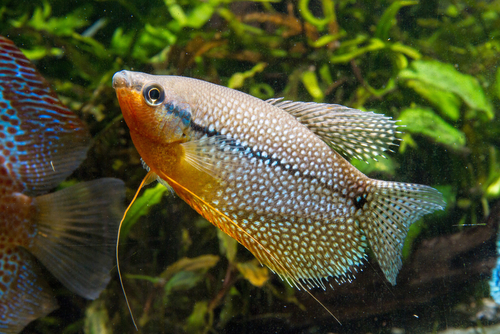With silvery-brown bodies decorated with a pearlescent pattern and a black line fading from head to caudal fin, the Pearl Gourami is a beautiful fish that’s also called the lace gourami. They are gentle aquatic creatures who are easy to care for and enjoy heavy vegetation, soft lighting, and dark-colored substrate.
While males get a tad aggressive during breeding seasons, they get along well with other placid fish species.
Some of the best Pearl Gourami tank mates include the Dwarf Gourami, Ember Tetra, the Bristlenose Pleco, Kuhli Loach, Cherry Barb, several species of Corydoras, and even shrimp. If you choose fish that share similar water and temperature parameters, you’re more likely to have fish that thrive and get along well in a community tank.
Here are the most ideal companions to share an aquarium with your Pearl Gourami.
Contents
The 15 Best Pearl Gourami Tank Mates
You will also like these other similar posts:
1. Panda Corydoras
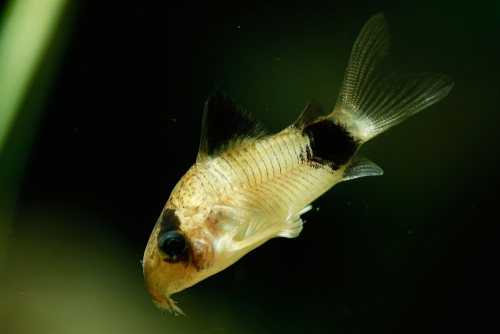
- Scientific name: Corydoras panda
- Origin: Peru
- Size: 2 inches
- Care level: Intermediate
One of the best kinds of fish to keep in a tank with Pearl Gourami is the gentle little armored Panda Corydoras. With their black-and-white pattern, these docile fish can add some interest to a community tank. Both fish species prefer similar water parameters, so they are a natural fit.
Since Panda Corydoras are bottom feeders, they won’t compete for food or space with Gourami who prefer the top of the tank. They’re also easy to care for but may need substrate adjusted to meet their environmental conditions.
Pros of keeping with pearl gourami
- Hardy, adaptable, and great tank cleaners
Cons of keeping with pearl gourami
- None
2. Glowlight Tetra
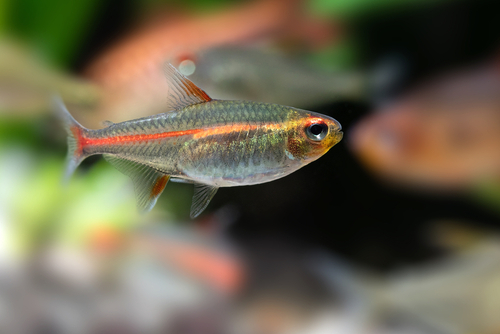
- Scientific name: Hemingrammus erythrozonus
- Origin: Guyana
- Size: 1.5 inches
- Care level: Easy
If you want to add some color and interest to your Gourami tank, consider getting a Glowlight Tetra. These fish get their name due to their glowing translucent golden bodies which have a deep red stripe running through their core and a few other pale blue patches on their underbelly.
These fish are cheerful tank mates who prefer to live in schools of their own kind.
Just like Gourami, these tetras enjoy similar water temperatures and soft water that has a slightly acidic pH level. You may want to consider dimming any bright lights around the tank by sprinkling leaf litter such as Indian Almond Leaves in the water or including floating plants to provide cover.
When these fish live in larger schools of eight fish or more, they act less skittish and engage in more calm, social, and interesting behavior.
Pros of keeping with pearl gourami
- Non-aggressive and adaptable
Cons of keeping with pearl gourami
- None
3. Neon Tetra
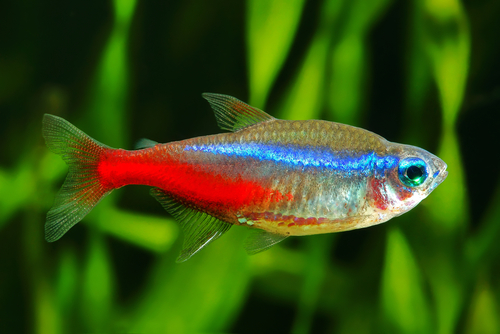
- Scientific name: Paracheirodon innesi
- Origin: Amazon Basin in South America
- Size: 1.5 inches
- Care level: Easy
A gorgeous fish with vibrant color from southeast Columbia, eastern Peru, and some areas in western Brazil, the Neon Tetra is a perfect tank mate for a Pearl Gourami. These flashy fish have similarly peaceful natures and spend most of their time floating in the middle area of an aquarium.
It’s recommended to keep them in a tank that holds at least 10 gallons. Graduate to a larger tank if you decide to add more fish to the aquarium. Avoid adding larger or more aggressive fish to the tank, since they are likely to eat the Neon Tetra.
With peaceful and social natures, these fish are also comfortable with a similar habitat to the Gourami.
Pros of keeping with pearl gourami
- Non-aggressive and beginner-friendly
Cons of keeping with pearl gourami
- None
4. Kuhli Loach
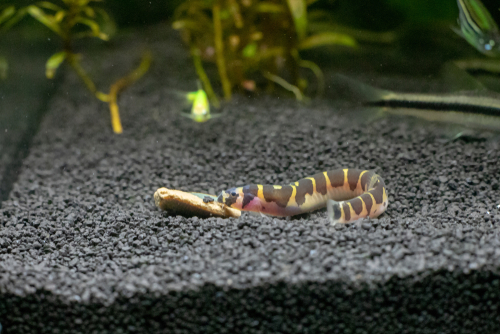
- Scientific name: Pangio kuhlii
- Origin: Jawa Indonesia
- Size: 3 inches
- Care level: Moderately difficult
A docile fish that likes to feed along the bottom of the tank, the Kuhli Loach is another fish that is a great companion for Pearl Gourami. Since they inhabit a completely different level of the tank, they won’t bother their mates who live and feed at the top of the water column.
Since these fish are nocturnal, they won’t provide much in terms of daylight entertainment. During the day, they crowd in to hide in rocks, caves, and other crevices. At night, they emerge to float around the tank. This alternate sleep cycle helps them avoid the other fish’s swimming and feeding patterns.
When kept in large groups, this fish can provide a lot of entertaining nighttime social behavior by zipping around their tank after dark.
Pros of keeping with pearl gourami
- Excellent tank cleaners
Cons of keeping with pearl gourami
- Susceptible to parasites and diseases
5. Cory Catfish
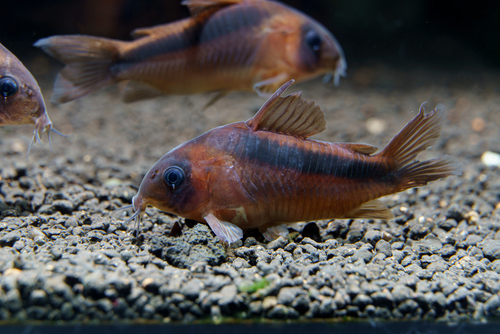
- Scientific name: Corydoras
- Origin: South America
- Size: 1 to 2.5 inches
- Care level: Easy
These unique fish have a stunning geometric look. Originating in South America, this species has a calm nature that contrasts with their striking bronze and black patterned bodies. With good care, these interesting fish can live up to five years old.
Like their potential Pearl Gourami tank mates, Cory Catfish are natural omnivores, which makes feeding very easy.
In the wild, Cory Catfish scavenge for worms, larvae, blood worms, tiny insects, and some plant vegetation. In a tank, it’s best to provide them with a mixed diet that includes algae wafers, plant matter, shrimp pellets, flakes, and blood worms to keep them in optimal health. You only need to feed them for 3-4 minutes once a day.
Just like most fish species, these fish prefer to live in a tank that recreates their natural habitat, so it’s important to fill the aquarium with a fine substrate and add some plants and driftwood.
They also prefer the same water temperature range and similar pH levels as pearl Gourami and Neon Tetras, which is another reason that these fish make great tank mates. Monitor and test the water nitrate levels to ensure that they don’t rise to avoid stressing out your Cory.
Pros of keeping with pearl gourami
- Hardy, adaptable, and non-aggressive
Cons of keeping with pearl gourami
- Like all bottom-feeders, it may prove hard to tell if they’re getting enough food
6. Harlequin Rasboras
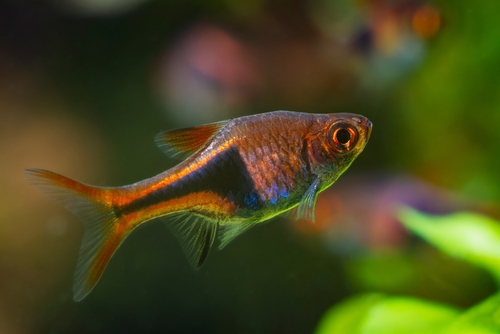
- Scientific name: Trigonostigma heteromorpha
- Origin: Malaysia, Sumatra, Singapore, and southern Thailand
- Size: 2 inches
- Care level: Easy
This small and shimmering schooling fish is a perfect choice if you want to inject some life and color into your community tank without causing any problems with your Gourami.
Active with colorful gold and black bodies, Harlequin Rasbora prefers the same kinds of water conditions as Pearl Gourami enjoy. This makes them good companions who will thrive in the same environment without stirring up any trouble.
The good news is that they also don’t require a large aquarium or complicated setup. They do enjoy a habitat that replicates their natural environment. Keep the tank calm and soothing with low lighting and streams full of live, low-light plants such as the Java Fern which doesn’t need bright sunlight and is easy to grow.
Pros of keeping with pearl gourami
- Hardy and non-aggressive
Cons of keeping with pearl gourami
- None
7. Ember Tetra
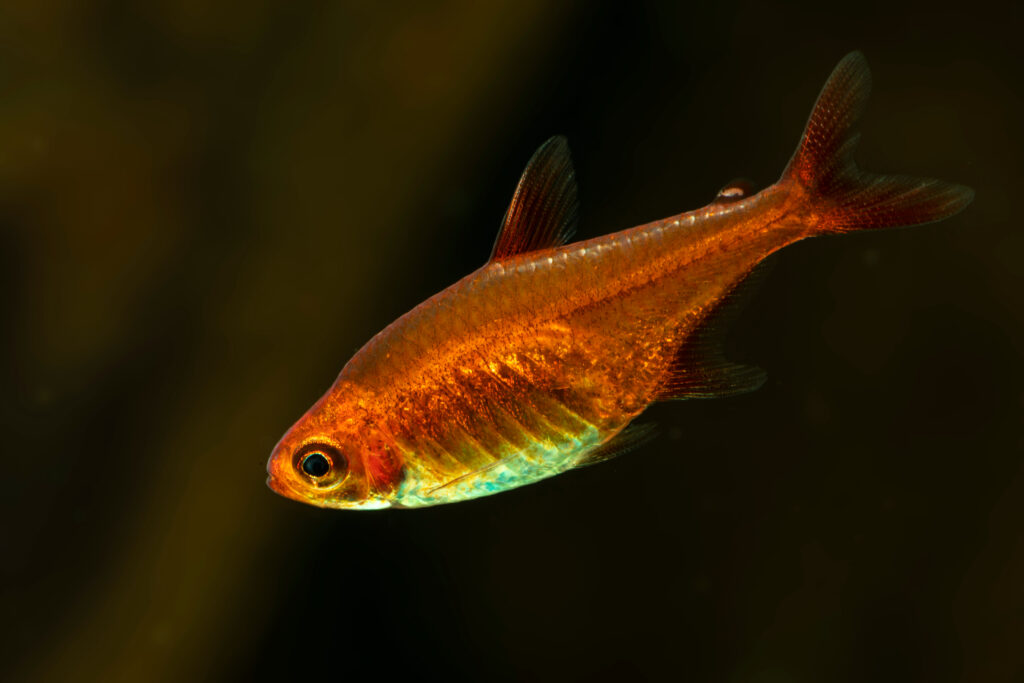
- Scientific name: Hyphessobrycon amandae
- Origin: Central Brazil
- Size: 0.8 inches
- Care level: Easy
These graceful crimson fish can add a splash of color to any aquarium. Compared to the Glowlight Tetra, Ember Tetras are a lot less active. They are also peaceful schooling fish, which not only means that they get along well with everybody but that their behavior is interesting to watch.
The good news is that Ember Tetra fish enjoy similar water parameters to Pearl Gourami, so you won’t need to try to balance a complicated system. These Tetras also need a large school of fish, ideally, 8-12 in number, to thrive and spawn. The larger the group, the more peaceful this species acts. They also require lots of floating plants and natural vegetation for coverage.
Pros of keeping with pearl gourami
- Non-aggressive and friendly
Cons of keeping with pearl gourami
- Prone to health issues.
8. Dwarf Gourami
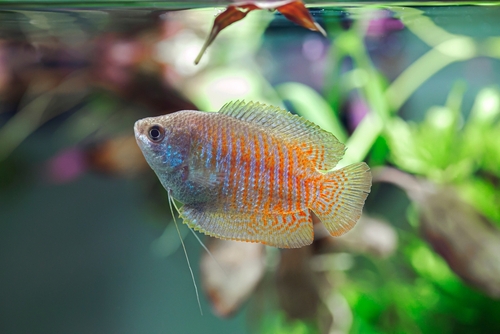
- Scientific name: Trichogaster Ialius
- Origin: India, Bangladesh, and Pakistan
- Size: 3.5 inches
- Care level: Intermediate
Just like a Pearl Gourami, the Dwarf Gourami is a mellow fish that comes from India, Bangladesh, Assam, and West Bengal. They play well with Pearl Gourami, which is a good thing since they are middle-tank dwellers who like to swim in the upper part of a fish tank.
As omnivorous eaters, Dwarf Gourami thrive in the same water temperature and pH parameters as their Pearl Gourami relatives.
Pros of keeping with pearl gourami
- Social, non-aggressive, and good for beginners.
Cons of keeping with pearl gourami
- Emit a high bio-waste load.
9. Otocinclus Catfish
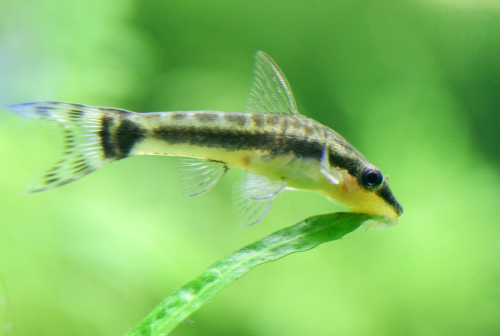
- Scientific name: Macrotocinclus affinis
- Origin: South America
- Size: 1.5 to 2 inches
- Care level: Easy
This is one of the best kinds of catfish to keep in the same tank as a Pearl Gourami. Not only are they peaceful pets, but they are a whizz at keeping your tank clean.
It’s important to know that the Otocinclus Catfish is tricky to care for and can’t tolerate even somewhat aggressive companions, so it’s best if you have some aquarium experience before buying this kind of fish.
You’ll want to keep at least five of them in a tank and supplement their natural algae diet with veggies and algae wafers.
Pros of keeping with pearl gourami
- Non-aggressive and clean tank glass and aquarium plants.
Cons of keeping with pearl gourami
- Need exceptionally clean water, and are delicate fish that need stable and consistent water parameters.
10. Cherry Barbs
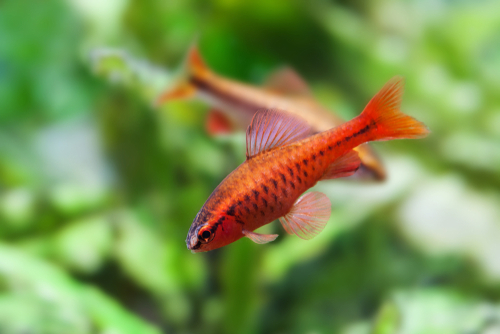
- Scientific name: Puntius titteya
- Origin: Sri Lanka, Columbia, and Mexico
- Size: 2 inches
- Care level: Easy
A Cherry Barb is the exception to the general no Barbs in a community tank rule. This is because Cherry Barbs are gentler and slower than their active and nippy cousins.
Their bright color makes them fun to watch, while they are peaceful fish who tend to mind their own business. Another plus is that Cherry Barbs are very adaptable to a wide range of parameters. If you want to watch the specie’s natural schooling fish behavior, it’s best to put at least 8 fish in the tank.
Pros of keeping with pearl gourami
- Non-aggressive and does not need much tank space.
Cons of keeping with pearl gourami
- Susceptible to parasites, bacterial diseases, and stress disorders like scale drop and fin rot.
11. Bristlenose Pleco
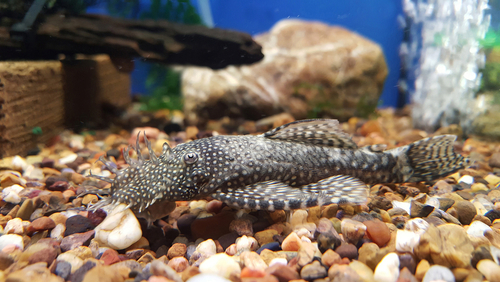
- Scientific name: Ancistrus cirrhosus
- Origin: South America, Amazon River Basin, Panama, and other parts of South and Central America.
- Size: 4 to 5 inches
- Care level: Intermediate
Like most smaller kinds of catfish, the Bristlenose Pleco isn’t the most active creature. They don’t swim around the tank much and like to spend feeding on the aquarium bottom suctioning their mouths against the glass. This means that they leave other fish alone and make perfect Pearl Gourami companions.
While these are small fish, it’s best to use them in larger tanks since they produce tons of waste that can ruin the water parameters in smaller aquariums.
Pros of keeping with pearl gourami
- Non-aggressive and help keep the tank clean.
Cons of keeping with pearl gourami
- They are heavy feeders and produce lots of waste.
12. Pygmy Corydoras
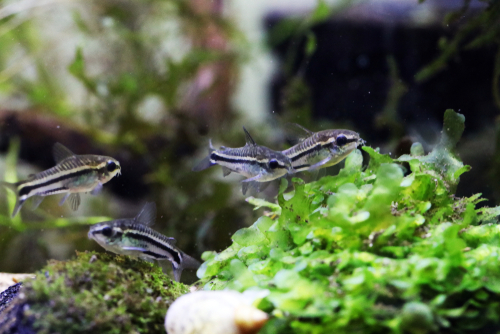
- Scientific name: Corydoras pygmaeus
- Origin: Trinidad, Brazil, and northern Argentina
- Size: 1 to 1.9 inches
- Care level: Moderate
You can never have too many Corydoras, or at least that’s what we think. In fact, there are certain kinds of Corydoras that pair best with Gourami fish.
These miniature Cories are different from the Panda Cory due to their tiny size and active behavior. Since Pygmy Corydoras are bottom-feeders, the top-feeding Gourami tends to leave them alone.
Pygmy Corydoras need to live in bigger groups, so you’ll want to have at least 10 Pygmy Corydoras in a tank. If there are fewer than 10 of them, these fish will spend most of their time hiding in rocks, driftwood, and caves. These fish are a breeze to care for, but make sure that they have a tank that holds at least 15 gallons.
Pros of keeping with pearl gourami
- Non-aggressive and efficient tank-cleaners.
Cons of keeping with pearl gourami
- May dig in substrate or uproot plants
13. Amano Shrimp

- Scientific name: Caridina multidentata
- Origin: Japan
- Size: 2 inches
- Care level: Easy
This delicate, golden shrimp originates in Japan and Taiwan. With distinctive horizontal dashes across their translucent bodies, Amano shrimp are lovely aquatic creatures to add to your community tank.
Unlike dwarf cherry shrimp, Amano Shrimp aren’t small enough to get bitten or eaten by Gourami or other tank mates.
These gentle beings also don’t pick fights and have a helpful habit of consuming algae which helps keep your tank healthy and clean. They enjoy eating algae wafers and bites of blanched spinach or zucchini. Amano Shrimp are also easy for beginners to keep and won’t overcrowd a tank.
Pros of keeping with pearl gourami
- Non-aggressive and keep tanks clean.
Cons of keeping with pearl gourami
- Prone to develop bacterial infections.
14. Dwarf Crayfish

- Scientific name: Cambarellus shufeldtii
- Origin: Southern United States and Mexico
- Size: 2 inches
- Care level: Moderate difficulty
Since they live in a different water level than the Gourami, Dwarf Crawfish tend to leave other fish alone. These bottom feeders aren’t aggressive and can fend for themselves.
These crayfish are simple to care for, have a peaceful nature, and do well in an 8-gallon tank. Just make sure to add lots of hiding places such as shrimp flats to your tank to keep your little aquatic critter happy.
Pros of keeping with pearl gourami
- Hardy and generally non-aggressive
Cons of keeping with pearl gourami
- Might destroy plants and tank décor.
15. Mystery Snail
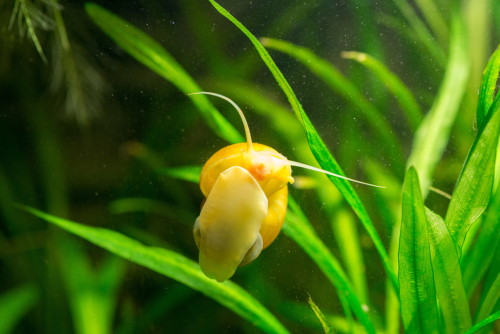
- Scientific name: Pomaca bridgesii
- Origin: Brazil, Bolivia, Peru, Paraguay, and China
- Size: 2 inches
- Care level: Easy
The Mystery Snail is a pleasant addition to a fish tank. These aquatic snails come in a range of attractive colors that include blue, yellow, white, and purple. Mystery Snails provide a useful function in any community tank since they help clean up the aquarium by picking up stray food and cleaning algae from glass, rocks, and substrate.
The Mystery Snail, just like the Apple Snail, is a smaller variety that tends to leave aquatic plants alone. They are also peaceful Gourami companions that are big enough to survive occasional curious nips from roaming Gourami. Due to their colorful appearance, they are fun to watch and make a unique addition to any tank.
Pros of keeping with pearl gourami
- Non-aggressive and oxygenates aquarium plants.
Cons of keeping with pearl gourami
- None
Final Thoughts
All these fish listed are highly compatible with Pearl Gourami in a community tank environment. Make sure to pick fish that are similar in size to help them feel safe and avoid aggressive behavior.
Schooling fish will exhibit better behavior when they live with a large group of their own species. It’s also a good idea to introduce fish that hang out and feed in different parts of a tank to avoid competition.
Since you can’t adjust water temperature and pH parameters for multiple kinds of fish, it’s important to add fish that thrive in a similar environmental range. If your fish don’t appear stressed, most species will adapt to slight water changes. Keep the community tank filled with natural plants, rocks, and driftwood to mimic a wild habitat to keep your fish comfortable and happy.

Ian Sterling, founder of Fishlab.com, began his aquarium journey over 30 years ago, driven by a deep fascination for fish and their diverse personalities. His website, Fishlab.com, is dedicated to making fishkeeping accessible and enjoyable, offering beginner-friendly guidance, expert insights, and a community for aquarists to connect and share experiences.


